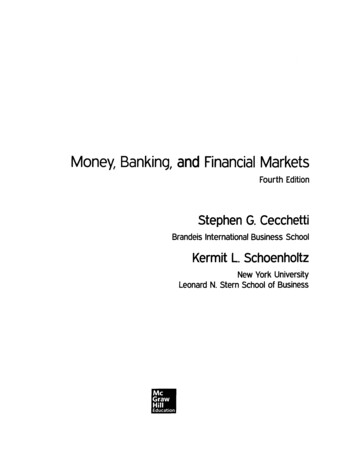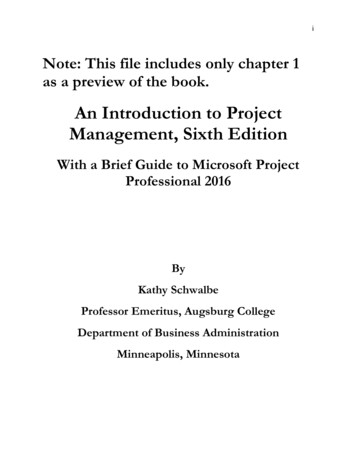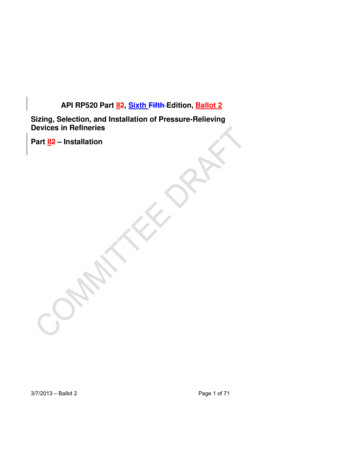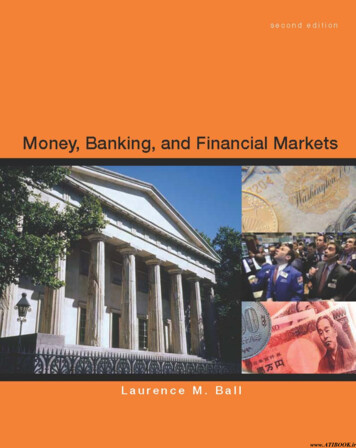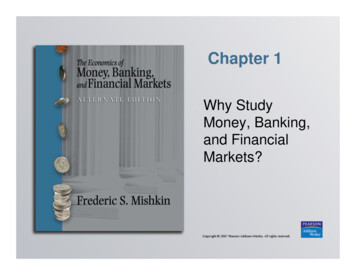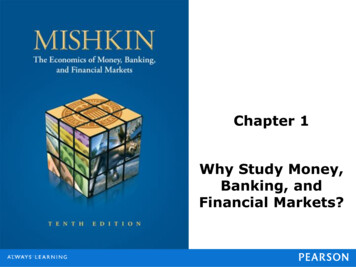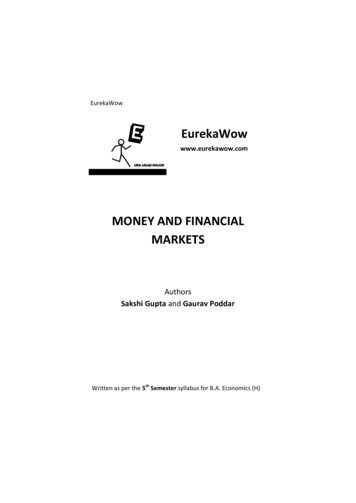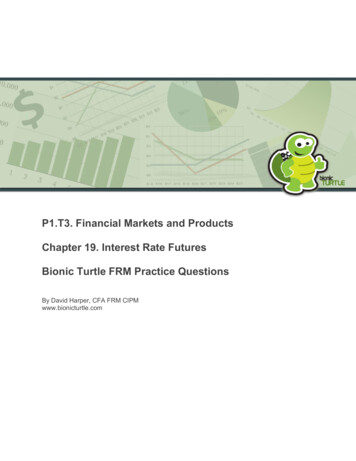
Transcription
Rev. Confirming Pagessixth editionFinancial Marketsand Institutionssau61663 fm i-xxiv.indd i7/22/14 4:10 PM
Rev. Confirming PagesTHE MCGRAW-HILL/IRWIN SERIES IN FINANCE, INSURANCEAND REAL ESTATEStephen A. RossFranco Modigliani Professor of Finance andEconomics, Sloan School of ManagementMassachusetts Institute of TechnologyConsulting EditorFINANCIAL MANAGEMENTBlock, Hirt, and DanielsenFoundations of Financial ManagementFifteenth EditionBrealey, Myers, and AllenPrinciples of Corporate FinanceEleventh EditionBrealey, Myers, and AllenPrinciples of Corporate Finance,ConciseSecond EditionBrealey, Myers, and MarcusFundamentals of Corporate FinanceEighth EditionBrooksFinGame Online 5.0BrunerCase Studies in Finance: Managing forCorporate Value CreationSeventh EditionRoss, Westerfield, and JaffeCorporate FinanceTenth EditionRose and MarquisFinancial Institutions and MarketsEleventh EditionRoss, Westerfield, Jaffe, and JordanCorporate Finance: Core Principlesand ApplicationsFourth EditionSaunders and CornettFinancial Institutions Management: A RiskManagement ApproachEighth EditionRoss, Westerfield, and JordanEssentials of Corporate FinanceEighth EditionSaunders and CornettFinancial Markets and InstitutionsSixth EditionRoss, Westerfield, and JordanFundamentals of Corporate FinanceTenth EditionShefrinBehavioral Corporate Finance: Decisionsthat Create ValueFirst EditionWhiteFinancial Analysis with an ElectronicCalculatorSixth EditionINVESTMENTSBodie, Kane, and MarcusEssentials of InvestmentsNinth EditionCornett, Adair, and NofsingerFinance: Applications and TheoryThird EditionBodie, Kane, and MarcusInvestmentsTenth EditionCornett, Adair, and NofsingerM: FinanceSecond EditionHirt and BlockFundamentals of Investment ManagementTenth EditionDeMelloCases in FinanceSecond EditionJordan, Miller, and DolvinFundamentals of Investments: Valuationand ManagementSeventh EditionGrinblatt (editor)Stephen A. Ross, Mentor: Influencethrough GenerationsGrinblatt and TitmanFinancial Markets and CorporateStrategySecond EditionHigginsAnalysis for Financial ManagementTenth EditionKellisonTheory of InterestThird Editionsau61663 fm i-xxiv.indd iiStewart, Piros, and HeislerRunning Money: Professional PortfolioManagementFirst EditionSundaram and DasDerivatives: Principles and PracticeFirst EditionINTERNATIONAL FINANCEEun and ResnickInternational Financial ManagementSeventh EditionREAL ESTATEBrueggeman and FisherReal Estate Finance and InvestmentsFourteenth EditionLing and ArcherReal Estate Principles: A ValueApproachFourth EditionFINANCIAL PLANNING ANDINSURANCEAllen, Melone, Rosenbloom, and MahoneyRetirement Plans: 401(k)s, IRAs,and Other Deferred CompensationApproachesEleventh EditionAltfestPersonal Financial PlanningFirst EditionHarrington and NiehausRisk Management and InsuranceSecond EditionKapoor, Dlabay, and HughesFocus on Personal Finance: An ActiveApproach to Help You Develop SuccessfulFinancial SkillsFourth EditionFINANCIAL INSTITUTIONS ANDMARKETSKapoor, Dlabay, and HughesPersonal FinanceEleventh EditionRose and HudginsBank Management and Financial ServicesNinth EditionWalker and WalkerPersonal Finance: Building Your FutureFirst Edition7/22/14 4:10 PM
Rev. Confirming Pagessixth editionFinancial Marketsand InstitutionsAnthony SaundersStern School of BusinessNew York UniversityMarcia Millon CornettBentley Universitysau61663 fm i-xxiv.indd iii7/22/14 4:10 PM
Rev. Confirming PagesFINANCIAL MARKETS AND INSTITUTIONS, SIXTH EDITIONPublished by McGraw-Hill Education, 2 Penn Plaza, New York, NY 10121. Copyright 2015 by McGraw-HillEducation. All rights reserved. Printed in the United States of America. Previous editions 2012, 2009, and2007. No part of this publication may be reproduced or distributed in any form or by any means, or stored ina database or retrieval system, without the prior written consent of McGraw-Hill Education, including, but notlimited to, in any network or other electronic storage or transmission, or broadcast for distance learning.Some ancillaries, including electronic and print components, may not be available to customers outside theUnited States.This book is printed on acid-free paper.1 2 3 4 5 6 7 8 9 0 DOW/DOW 1 0 9 8 7 6 5 4ISBN 978-0-07-786166-7MHID 0-07-786166-3Senior Vice President, Products & Markets: Kurt L. StrandVice President, General Manager, Products & Markets: Marty LangeVice President, Content Production & Technology Services: Kimberly Meriwether DavidManaging Director: Douglas ReinerExecutive Brand Manager: Chuck SynovecExecutive Director of Development: Ann TorbertDevelopment Editor II: Noelle BathurstDirector of Digital Content: Doug RubyDigital Development Editor: Meg M. MaloneyDigital Product Analyst: Kevin ShanahanExecutive Marketing Manager: Melissa S. CaughlinDirector, Content Production: Terri SchieslContent Project Manager: Brent dela CruzSenior Buyer: Michael R. McCormickDesign: Matthew BaldwinCover Image: ThinkstockTypeface: 10/12 Times LTCompositor: Laserwords Private LimitedPrinter: R. R. DonnelleyAll credits appearing on page or at the end of the book are considered to be an extension of the copyright page.Library of Congress Cataloging-in-Publication DataSaunders, Anthony, 1949Financial markets and institutions/Anthony Saunders, Stern School of Business, New York University,Marcia Millon Cornett, Bentley University.—Sixth edition.pages cmIncludes bibliographical references and index.ISBN 978-0-07-786166-7 (alk. paper)—ISBN 0-07-786166-3 (alk. paper)1. Securities—United States. 2. Stock exchanges—United States. 3. Financial institutions—United States. 4. Rate of return—United States. 5. Interest rates—United States. I. Cornett,Marcia Millon. II. Title.HG4910.S28 2015332—dc232014017298The Internet addresses listed in the text were accurate at the time of publication. The inclusion of a website doesnot indicate an endorsement by the authors or McGraw-Hill Education, and McGraw-Hill Education does notguarantee the accuracy of the information presented at these sites.www.mhhe.comsau61663 fm i-xxiv.indd iv7/22/14 4:10 PM
Rev. Confirming PagesTo Ingo Walter: a mentor, co-author, and friend.—TONY SAUNDERSTo my parents, Tom and Sue.—MARCIA MILLON CORNETTsau61663 fm i-xxiv.indd v7/22/14 4:10 PM
Rev. Confirming PagesABOUT THE AUTHORSAnthony SaundersMarcia Millon CornettAnthony Saunders is the John M. Schiff Professor of FinanceMarcia Millon Cornett is the Robert A. and Julia E. Dornand former Chair of the Department of Finance at the SternProfessor of Finance at Bentley University. She received herSchool of Business at New York University. ProfessorB.S. degree in economics from Knox College in Galesburg,Saunders received his Ph.D. from the London School ofIllinois, and her M.B.A. and Ph.D. degrees in finance fromEconomics and has taughtIndiana University in Bloomington, Indiana. Dr. Cornett hasboth undergraduate and grad-written and published several articles in the areas of bankuate level courses at NYUperformance, bank regulation, corporate finance, and invest-since 1978. Throughout hisments. Articles authored by Dr. Cornett have appeared in suchacademic career, his teachingacademic journals as the Journal of Finance, the Journal ofand research have special-Money, Credit, and Banking, the Journal of Financial Econom-ized in financial institutionsics, Financial Management, and the Journal of Banking andand international banking. HeFinance. In 2008, she was ranked the 124th most publishedhas served as a visiting professor all over the world, includ-out of more than 17,600 authors and the number five femaleing INSEAD, the Stockholm School of Economics, and theauthor in finance literature over the last 50 years. Along withUniversity of Melbourne.Anthony Saunders, Dr. Cornett has recently completed workProfessor Saunders holds or has held positions on theon the eighth edition of Financial Institutions ManagementBoard of Academic Consultants of the Federal Reserve Board(McGraw-Hill/Irwin).of Governors as well as the Council of Research AdvisorsTroy A. Adair, Jr. (HarvardWithfor the Federal National Mortgage Association. In addition,University) and John NofsingerDr. Saunders has acted as a visiting scholar at the Comptrol-(University of Alaska, Anchor-ler of the Currency and at the International Monetary Fund.age), she has also recentlyHe is editor of the Journal of Financial Markets, Instrumentscompleted work on the thirdand Institutions, as well as the associate editor of a numberedition of Finance: Applica-of other journals. His research has been published in all oftions and Theory and the secondthe major finance and banking journals and in several books.edition of M: Finance (McGraw-Hill/Irwin). ProfessorHe has just published a new edition of his textbook, with Dr.Cornett serves as an associate editor for the Journal of Bank-Marcia Millon Cornett, Financial Institutions Management: Aing and Finance, the Journal of Financial Services Research,Risk Management Approach for McGraw-Hill (eighth edition)Review of Financial Economics, Financial Review, and Multi-as well as a third edition of his book on credit risk measure-national Finance Journal. Dr. Cornett has served as a memberment for John Wiley & Sons. Professor Saunders was rankedof the Board of Directors, the Executive Committee, and thethe most prolific author out of more than 5,800 who have pub-Finance Committee of the SIU Credit Union. Dr. Cornett haslished in the seven leading Finance academic journals fromalso taught at Southern Illinois University at Carbondale, the1959–2008 (“Most Prolific Authors in the Financial Litera-University of Colorado, Boston College, Southern Methodistture, 1959–2008,” Jean Heck and Philip Cooley).University, and Boston University.visau61663 fm i-xxiv.indd vi7/22/14 4:10 PM
Rev. Confirming PagesPREFACEhe last 25 years have been dramatic for the financial services industry. Inthe 1990s and 2000s, boundaries between the traditional industry sectors,such as commercial banking and investment banking, broke down and competition became increasingly global in nature. Many forces contributed tothis breakdown in interindustry and intercountry barriers, including financialinnovation, technology, taxation, and regulation. Then in 2008–2009, thefinancial services industry experienced the worst financial crisis since the Great Depression. Even into the mid-2010s, the U.S. and world economies have not recovered from thiscrisis. It is in this context that this book is written.As the economic and competitive environments change, attention to profit and, morethan ever, risk become increasingly important. This book offers a unique analysis of therisks faced by investors and savers interacting through both financial institutions and financial markets, as well as strategies that can be adopted for controlling and better managingthese risks. Special emphasis is also put on new areas of operations in financial marketsand institutions such as asset securitization, off-balance-sheet activities, and globalizationof financial services.While maintaining a risk measurement and management framework, Financial Markets and Institutions provides a broad application of this important perspective. This bookrecognizes that domestic and foreign financial markets are becoming increasingly integrated and that financial intermediaries are evolving toward a single financial servicesindustry. The analytical rigor is mathematically accessible to all levels of students, undergraduate and graduate, and is balanced by a comprehensive discussion of the unique environment within which financial markets and institutions operate. Important practical toolssuch as how to issue and trade financial securities and how to analyze financial statementsand loan applications will arm students with the skills necessary to understand and manage financial market and institution risks in this dynamic environment. While descriptiveconcepts, so important to financial management (financial market securities, regulation,industry trends, industry characteristics, etc.) are included in the book, ample analyticaltechniques are also included as practical tools to help students understand the operation ofmodern financial markets and institutions.TINTENDED AUDIENCEFinancial Markets and Institutions is aimed at the first course in financial markets andinstitutions at both the undergraduate and M.B.A. levels. While topics covered in this bookare found in more advanced textbooks on financial markets and institutions, the explanations and illustrations are aimed at those with little or no practical or academic experiencebeyond the introductory level finance courses. In most chapters, the main relationships arepresented by figures, graphs, and simple examples. The more complicated details and technical problems related to in-chapter discussion are provided in appendixes to the chapters(available through McGraw-Hill Connect Finance or your course instructor).ORGANIZATIONSince our focus is on return and risk and the sources of that return and risk in domestic andforeign financial markets and institutions, this book relates ways in which a modern financial manager, saver, and investor can expand return with a managed level of risk to achievethe best, or most favorable, return–risk outcome.Part 1 provides an introduction to the text and an overview of financial markets andinstitutions. Chapter 1 defines and introduces the various domestic and foreign financialmarkets and describes the special functions of FIs. This chapter also takes an analyticallook at how financial markets and institutions benefit today’s economy. In Chapter 2, weviisau61663 fm i-xxiv.indd vii7/22/14 4:10 PM
Rev. Confirming PagesviiiPrefaceprovide an in-depth look at interest rates. We first look at factors that determine interestrate levels, as well as their past, present, and expected future movements. We then reviewthe concept of time value of money. Chapter 3 then applies these interest rates to securityvaluation. In Chapter 4, we describe the Federal Reserve System and how monetary policy implemented by the Federal Reserve affects interest rates and, ultimately, the overalleconomy.Part 2 of the text presents an overview of the various securities markets. We describeeach securities market, its participants, the securities traded in each, the trading process,and how changes in interest rates, inflation, and foreign exchange rates impact a financialmanager’s decisions to hedge risk. These chapters cover the money markets (Chapter 5),bond markets (Chapter 6), mortgage markets (Chapter 7), stock markets (Chapter 8), foreignexchange markets (Chapter 9), and derivative securities markets (Chapter 10).Part 3 of the text summarizes the operations of commercial banks. Chapter 11describes the key characteristics and recent trends in the commercial banking sector.Chapter 12 describes the financial statements of a typical commercial bank and the ratiosused to analyze those statements. This chapter also analyzes actual financial statementsfor representative commercial banks. Chapter 13 provides a comprehensive look at theregulations under which these financial institutions operate and, particularly, the effect ofrecent changes in regulation.Part 4 of the text provides an overview describing the key characteristics andregulatory features of the other major sectors of the U.S. financial services industry.We discuss other lending institutions (savings institutions, credit unions, and financecompanies) in Chapter 14, insurance companies in Chapter 15, securities firms andinvestment banks in Chapter 16, investment companies in Chapter 17, and pension fundsin Chapter 18.Part 5 concludes the text by examining the risks facing a modern FI and FI managers and the various strategies for managing these risks. In Chapter 19, we previewthe risk measurement and management chapters in this section with an overview of therisks facing a modern FI. We divide the chapters on risk measurement and managementalong two lines: measuring and managing risks on the balance sheet, and managing risksoff the balance sheet. In Chapter 20, we begin the on-balance-sheet risk measurementand management section by looking at credit risk on individual loans and bonds andhow these risks adversely impact an FI’s profits and value. The chapter also discussesthe lending process, including loans made to households and small, medium-size, andlarge corporations. Chapter 21 covers liquidity risk in financial institutions. This chapter includes a detailed analysis of the ways in which FIs can insulate themselves fromliquidity risk and the key role deposit insurance and other guarantee schemes play inreducing liquidity risk.In Chapter 22, we investigate the net interest margin as a source of profitability andrisk, with a focus on the effects of interest rate risk and the mismatching of asset and liability maturities on FI risk exposure. At the core of FI risk insulation is the size and adequacyof the owner’s capital stake, which is also a focus of this chapter.The management of risk off the balance sheet is examined in Chapter 23. The chapterhighlights various new markets and instruments that have emerged to allow FIs to better manage three important types of risk: interest rate risk, foreign exchange risk, andcredit risk. These markets and instruments and their strategic use by FIs include forwards,futures, options, and swaps.Finally, Chapter 24 explores ways of removing credit risk from the loan portfoliothrough asset sales and securitization.sau61663 fm i-xxiv.indd viii7/22/14 4:10 PM
Rev. Confirming PagesPrefaceixNEW FEATURESKey changes to this edition include the following: Tables and figures in all chapters have been revised to include the most recentlyavailable data.New boxes highlighting significant events occuring “After the Crisis” have been addedto chapters throughout the book.Major changes proposed for the regulation of financial institutions have been includedand updated where appropriate.How financial markets and institutions continue to recover from the financial crisis isdiscussed throughout the book. Virtually every chapter includes new material detailing how the financial crisis has affected risk management in financial institutions.New end-of-chapter questions and problems have been added to all chapters.Several chapters include a discussion of the European debt crisis and how it hasaffected the risk and return for investors and financial institutions.Chapter 1 includes a new section on shadow banks. The chapter also provides anupdate on the implementation of the Wall Street Reform and Consumer ProtectionAct, which was enacted as a result of the financial crisis.Chapter 4 provides an update on the Federal Reserve’s actions intended to strengthen theU.S. economy, including the various quantitative easing programs instituted by the Fed.Chapter 5 includes coverage of the Fed’s new Treasury auction process, as well as adiscussion of the LIBOR scandal.Chapter 7 provides an update of the status of Fannie Mae and Freddie Mac.Chapter 8 includes coverage of the merger of NYSE Euronext and ICE.Chapter 13 includes a discussion of Basel III capital adequacy rules. The majorchanges are described in detail. Many in-chapter examples and end-of-chapter problems have been added to illustrate the many complex changes to capital adequacycalculations.Chapter 16 includes a discussion of the losses incurred by J. P. Morgan Chase fromderivatives trading by the “London Whale,” as well as various other scandals plaguinginvestment banks.Chapter 17 has been retitled “Investment Companies” to capture the broader nature ofthe investment fund industry.Chapter 21 includes a detailed discussion and examples of the new internationalliquidity standards enacted as a result of the financial crisis.ACKNOWLEDGMENTSWe take this opportunity to thank all of those individuals who helped us prepare this andprevious editions. We want to express our appreciation to those instructors whose insightful comments and suggestions were invaluable to us during this revision.Amanda AdkissonTexas A&M UniversityGreg ArburnUniversity of FindlayMurat AydogduRhode Island CollegeNate BarberUniversity of South Carolinasau61663 fm i-xxiv.indd ixEmily BreitFort Hays State UniversityEileen EichlerFarmingdale State CollegeLeo-Rey GordonWilmington UniversityArthur GuarinoRutgers University–Newark7/22/14 4:10 PM
Rev. Confirming PagesxPrefaceGerald HanweckGeorge Mason UniversityMahfuzul HaqueIndiana State University–Terre HauteHelena HeMississippi State UniversityJian HuangCalifornia State University–ChicoWilliam HudsonSaint Cloud State UniversityAdam KesslerFairleigh Dickinson University–TeaneckVladimir KotominIllinois State UniversityAndrew LightLiberty UniversityDavinder MalhotraPhiladelphia UniversityBarry MarchmanGeorgia Institute of TechnologyJohn MasserwickFarmingdale State CollegeRobert McLeodUniversity of Alabama–TuscaloosaJeff MooreUniversity of Texas–ArlingtonMelissa MorganMississippi State UniversityBrett MyersTexas Tech UniversityBabatunde OdusamiWidener UniversityMichael PalmerUniversity of Colorado–BoulderShobha PremkumarIowa State UniversityMitchell RatnerRider UniversityRobert SchweitzerUniversity of DelawareJohn StockerUniversity of DelawareJ. C. “Duke” ThompsonNorthern Kentucky UniversityBruce ToewsWalla Walla UniversityHolland TolesTexas State University–San MarcosDaniel TowerKean UniversityDeniz TudorSan Francisco State UniversityPhil UhlmannBentley UniversityEmre UnluUniversity of Nebraska–LincolnGwendolyn WebbBaruch CollegeJohn WeissUniversity of BaltimoreDavid WozniakUniversity of North Texas–DallasWe would like to thank the staff at McGraw-Hill for their help and guidance, especiallyChuck Synovec, executive brand manager; Noelle Bathurst, development editor; Brent delaCruz, content project manager; Kevin Shanahan, digital product analyst; Melissa Caughlin,marketing manager; Jennifer Jelinski, marketing specialist; and Michael McCormick,senior buyer. Additional thanks to Sarah Otterness, Christina Kouvelis, Casey Rasch,Christina Holt, and Jennifer Schurer for their editorial assistance. We are also grateful toour secretaries and assistants, Rebecca Roach, Rhianna Joffrion, and Brenda Webb.Anthony SaundersMarcia Millon Cornettsau61663 fm i-xxiv.indd x7/22/14 4:10 PM
Rev. Confirming PagesWALKTHROUGHChapter FeaturesThe following special features have beenintegrated throughout the text to encouragestudent interaction and to aid students inabsorbing and retaining the material.O U T L I N EInterest Rate Fundamentals:Chapter OverviewLLoanable Funds TheorySupply of Loanable FundsCHAPTER-OPENING OUTLINESThese outlines offer students a snapshot viewof what they can expect to learn from eachchapter’s discussion.Demand for Loanable FundsEquilibrium Interest RateFactors That Cause theSupply and Demand Curvesfor Loanable Funds to ShiftMovement of Interest RatesiLG 4-1Understand the major functions of the Federal Reserve System.LG 4-2Identify the structure of the Federal Reserve System.LG 4-3Identify the monetary policy tools used by the Federal Reserve.LG 4-4Appreciate how monetary policy changes affect key economic variables.LG 4-5Understand how central banks around the world adjusted their monetary making body of the FederalReserve System.the recent financial crisis.Federal Open MarketCommittee (FOMC)The major monetary policy-LEARNING GOALSLearning goals (LGs) appear at the beginning ofeach chapter to provide a quick introduction tothe key chapter material. These goals are alsointegrated with the end-of-chapter questionsand problems, which allows instructors to easilyemphasize the learning goal(s) as they choose.www.occ.treas.govwww.fdic.govThe Federal Reserve Boardregulation of (1) all bank holdingsubsidiaries), (2) state-chartered(state-chartered member banks),which U.S. banks conduct foreiglatory responsibilities with stateincluding overseeing both the opStates and the establishment, exaing subsidiaries, and representaBoard approves member bank meactivities of bank holding compaand administration of regulationsTruth in Lending Act, the Equaland Consumer Protection Act oopen market operationsPurchases and sales of U.S.government and federalThe Federal Open Marketbody of the Federal Reservemembers of the Federal ReseBank of New York, and the pbasis). The chairman of the Bis required to meet at least folarly scheduled meetings havThe main responsibilitiemployment, economic growtrade. The FOMC seeks to aoperations. Open market operal agency securities—is thtargets (although the operatioBOLD KEY TERMS AND A MARGINALGLOSSARYThe main terms and concepts are emphasizedthroughout the chapter by bold key terms calledout in the text and defined in the margins.PERTINENT WEB ADDRESSESWebsite addresses are referenced in thesau61663 ch02 026-056.indd 26margins throughouteach chapter, providingadditional resources to aid in the learningprocess.xisau61663 ch04 091-126.indd 91sau61663 fm i-xxiv.indd xi5/13/14 5:40 PM7/22/14 4:10 PM
Rev. Confirming PagesPedagogical FeaturesD O YO U U N D E R S TA N D :1.What the main functions of FederalReserve Banks are?2.What the main responsibilities of theFederal Reserve Board are?3.How the FOMC implementsmonetary policy?4.What the main assets and liabilitiesof the Federal Reserve are?backed by Fannie Mae, Freprogram, the FOMC calledThe purchase activity begaThus, the Fed expanded itsmarkets.Gold and Foreign Exchanholds Treasury gold certifgold. The Fed also holds smdenominated assets to assi“IN THE NEWS” BOXESThese boxes demonstrate the application ofchapter material to real current events.IN THE NEWSIN-CHAPTER EXAMPLESThese examples provide numericaldemonstrations of the analytical materialdescribed in many chapters.EXAMPLE 2–1“DO YOU UNDERSTAND” BOXESThese boxes allow students to test themselveson the main concepts presented within eachmajor chapter section. Solutions are providedin Connect.Banks Flock toDiscount Windowsult, the federal funds rate regularly fell wellofficials are expected to cut the federal funds ratehe target rate of 5.25 percent. The Fed alsofor the first time in four years. Markets widelythe discount rate byRatesa half percentage pointCalculations of Real Risk-Freepercent, in a bid to encourage banks toexpect at least a quarter point cut to 5 percent,The one-year Treasury bill rate in 2007 averaged 4.53 percent and inffrom thepercent.Fed. But theIfFedhad littleby the consumer price index) for the yeardirectlywas 4.10investorsspurringthe percent),discount windowborrowing.same inflation rate as that actually realized in(i.e.,4.10thenaccordeffect the real risk-free rate for 2007 was: ypically are reluctant to borrow from thethough some analysts say a half point cut is possible. The smaller cut might have less effect onfinancial markets because it would simply bring thenew target down to where interest rates had been4.53% - 4.10% 0.43%The one-year T-bill rate in 2012 was 0.17 percent, while the CPI chwas 1.70 percent. This implies a real risk-free rate of -1.53 percent, thaAFTER THE CRISISsau61663 ch04 091-126.indd 102Traders Manipulated Key Rate,Several banks are being investigated by Canada’spay to borrow from banks for different perioCompetition Bureau (CCB) after the discovery of atime. Thomson Reuters then discards the topplan designed to manipulate interest rates interna-bottom four rate quotes, and the eight remationally. According to a court filing in Ottawa, one ofquotes are used to average the LIBOR. Accoseveral banks currently under investigation statedto the court documents, a group of traders a5/13/14 7:38 PM“AFTER THE CRISIS” BOXESThese boxes use articles pertaining to eventscaused or affected by the 2008–2009 financialcrisis to elaborate on chapter material.INTERNATIONAL MONETARY POLICIES AND STRATEGIESINTERNATIONAL COVERAGEAn international icon appears in the margin toeasily communicate where international materialis being introduced.Central banks guide the monetary policy in virpean Central Bank (ECB) is the central bank fEngland is the central bank of the United Kinindependent central banks whose decisions doIn contrast, the People’s Bank of China, the Rof Brazil are less independent in that the goverthe operations of these central banks. Independthe bank is free from pressure from politicianxiisau61663 fm i-xxiv.indd xii7/22/14 4:10 PM
Rev. Confirming PagesWALKTHROUGHEnd-of-Chapter FeaturesEXCEL PROBLEMSExcel problems are featured in selected chaptersand are denoted by an icon. Spreadsheettemplates are available in Connect.yIn 8 yearsIn 10 years5.54,14355,231,,54,143 0.05 28 78,80055,231 0.05 30 82,847xcelUsing a Spreadsheet to Calculate PensionBenefit Payments: Your employer uses a finalpay formula to determine retirement payments to itsemployees. You have 20 years of service at the company andare considering retirement some time in the next 10 years.Your employer uses a final pay formula by which youreceive an annual benefit payment of 4 percent of your average salary over the last three years of service times the number of years employed. Calculate the annual benefit if youretire now, in 2 years, 5 years, 8 years, and 10 years usingthe estimated annual salary during the last three years ofservice listed below. (LG 18-2)eQUESTIONS1. Who are the suppliers of loanable funds? (LG 2-1)2. Who are the demanders of loanable funds? (LG 2-2)3. What factors cause the supply of funds curve to shift? (LG 2-4)4. What factors cause the demand for funds curve to shift?(LG 2-4)5. What are six factors that determine the fair interest rate on asecurity? (LG 2-6)6. What should happen to a security’s fair interest rate as thesecurity’s liquidity risk increases? (LG 2-6)sau61663 ch18 548-568.indd 5677. Discuss and compare the three explanations for the shape ofthe yield curve. (LG 2-7)11END-OF-CHAPTER QUESTIONS ANDPROBLEMSThe questions and problems in the end-ofchapter material appear in separate s
Financial Markets and Corporate Strategy Second Edition Higgins Analysis for Financial Management enth T Edition Kellison Theory of Interest Third Edition Ross, Westerfield, and Jaffe Corporate Finance enth T Edition Ross, Westerfield, Jaffe, and Jordan Corporate Finance: Core Pr
